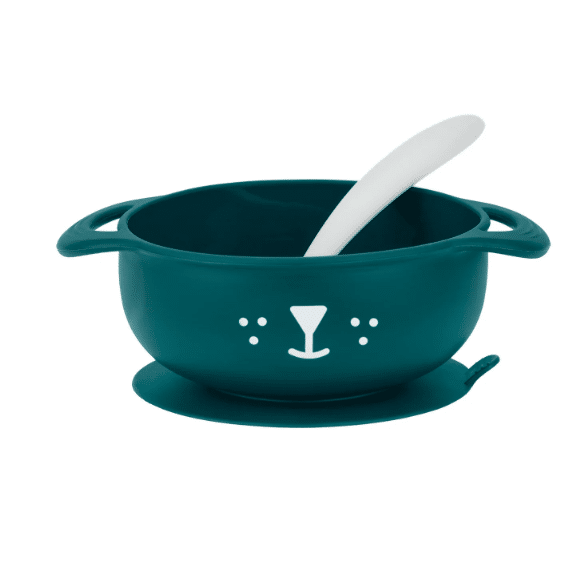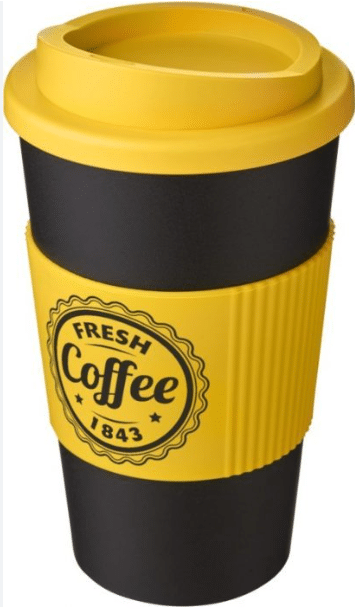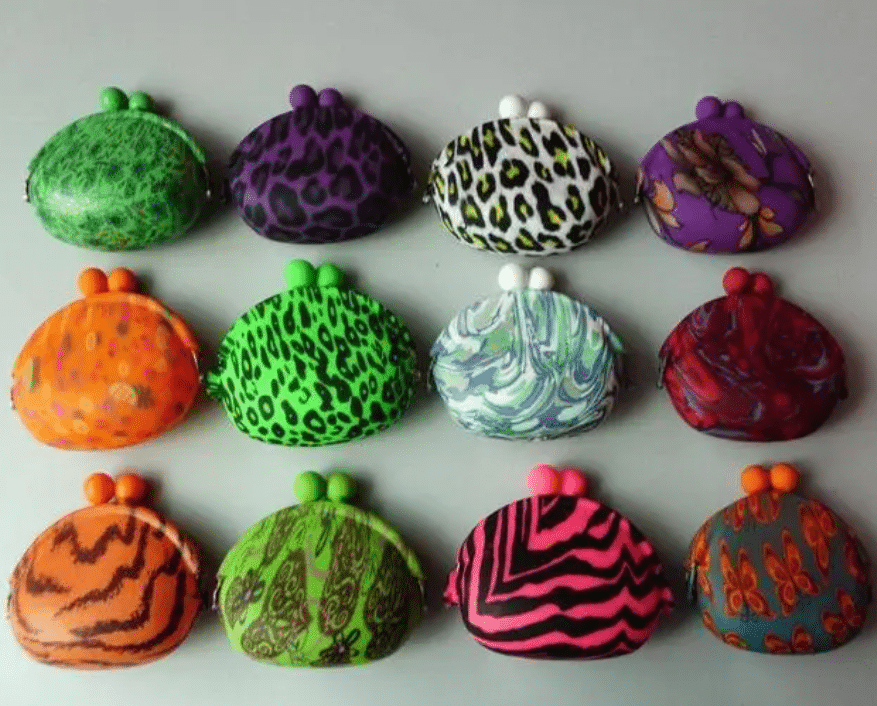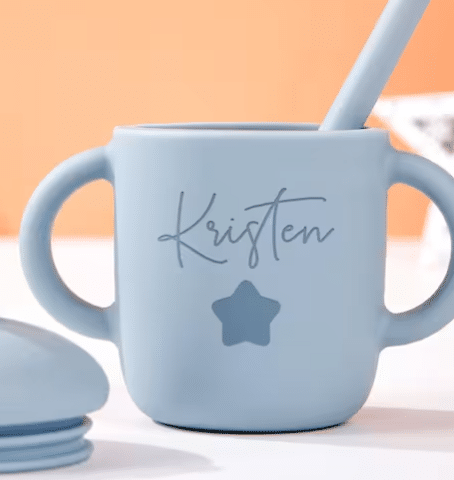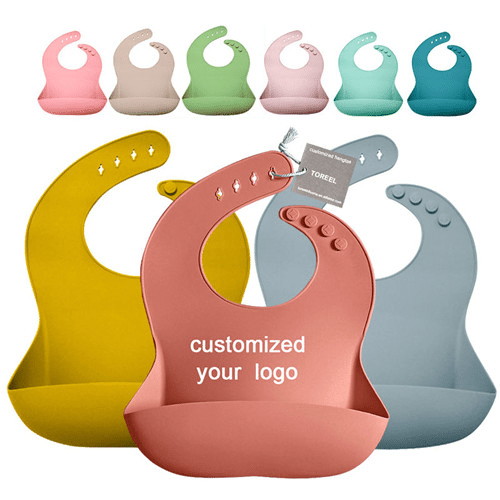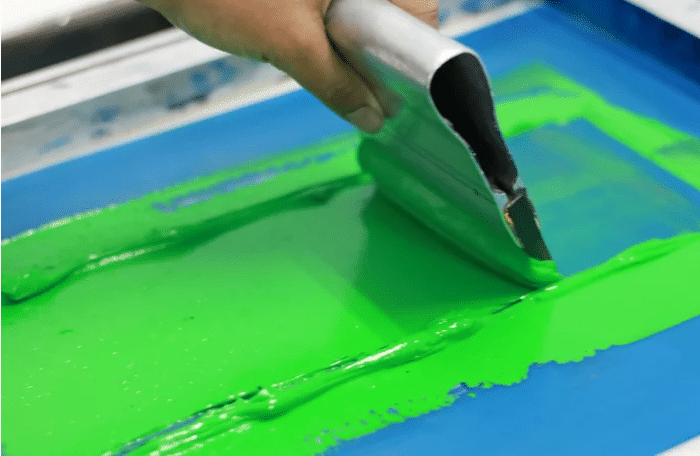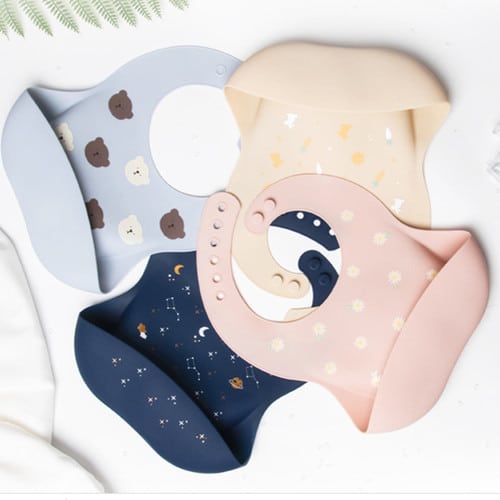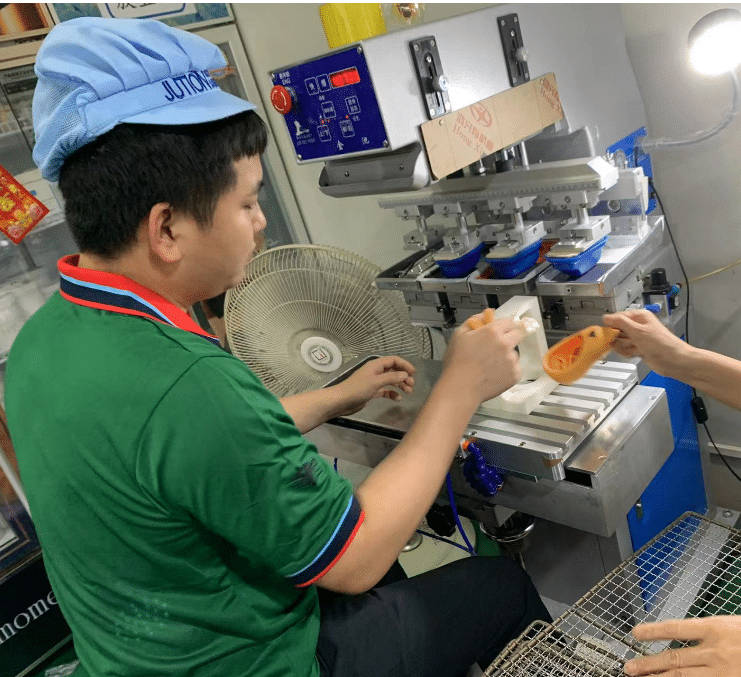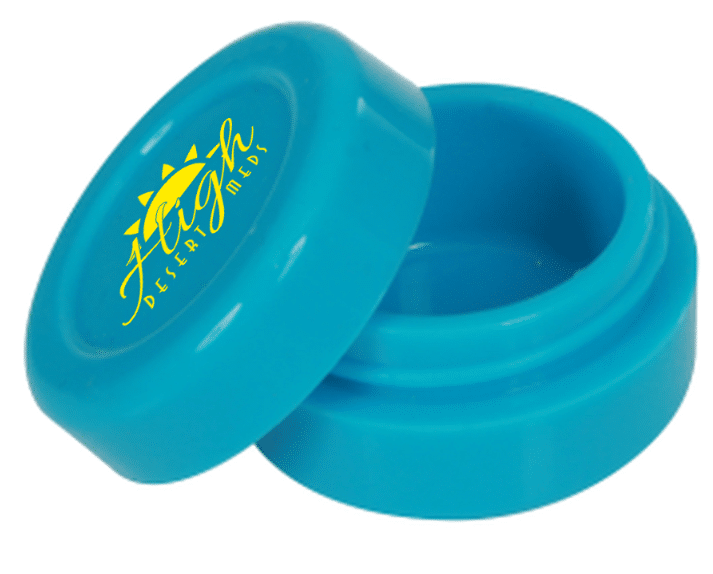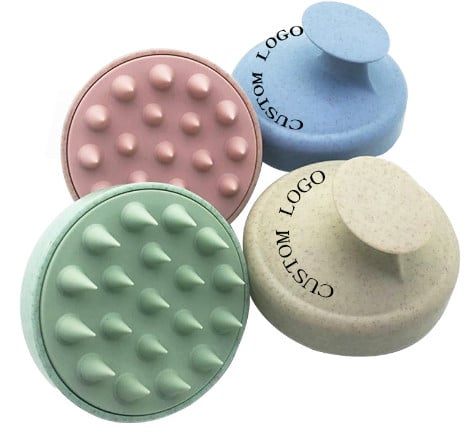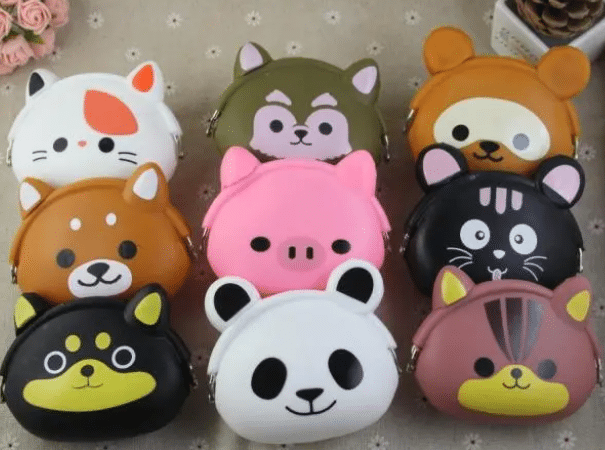Pad Printing Pattern or logo on silicone products
Pad printing, also called tampography or tampo printing, is an indirect offset (gravure) printing process where a silicon pad takes a 2-D image from a laser engraved (etched) printing plate (also called cliché) and transfers it to 3-D products.
Thanks to pad printing, it is now possible to print all kind of difficult-shaped products such as curved (convex), hollow (concave), cylindrical, spherical, compound angles, textures, etc. which were not available with traditional printing processes.
What is pad printing?
Pad printing is a printing process that can transfer a 2-D image onto a 3-D object (e.g., a silicone cup). This is accomplished using an indirect offset (gravure) printing process that involves an image being transferred from the cliché via a silicone pad onto a substrate. Pad printing is used for printing on otherwise difficult to print on products in many industries including medical, promotional, brand, and baby objects, as well as appliances, sports equipment and toys. It can also be used to deposit functional materials such as conductive inks, adhesives, dyes and lubricants.
Physical changes within the ink film both on the cliché and on the pad allow it to leave the etched image area in favor of adhering to the pad, and to subsequently release from the pad in favor of adhering to the substrate.
The unique properties of the silicone pad enable it to pick the image up from a flat plane and transfer it to a variety of surfaces, such as flat, cylindrical, spherical, compound angles, textures, concave, or convex surfaces.
A Brief History of Pad printing
The origins of pad printing can be traced back more than 200 years when the first off-set type of hand transfer printing was done using a bag of soft gelatin material to transfer the image. The first transfer printing plates were crafted from copper and were meticulously engraved by hand. Today they are photo-chemically etched onto hardened steel. This type of hand transfer was originally used in the transferring of images onto “blue” china plates and dinnerware.
The first true industrial application using a mechanical pad printer was accomplished much later in Switzerland to imprint watch faces. Soon thereafter a German firm was known to have developed a pad printer and the first application was reported to be for the imprinting the multi-color eyes of the china dolls. This industrial process was implemented to help speed production along and eliminate intensive skills.
The replacement of gelatin came sometime after WWII with the development of RTV silicone compounds. With the development of silicone transfer pads, the pad printing process has become an exacting method of imprinting on industrial products.
pad printing is not well known as a printing process, but we see touchpad-printed items every day. For example:
- Industrial Buttons and Keys as found on calculators, telephones and computer keyboards
- Electrical Household Appliances such as iron, VCR, TV, coffee pots, telephones, etc.
- Large Industrial Appliance panels such as on dishwashers, washing machines and dryers
- Toys such as figurines, dolls, cars, infant bottles, pacifiers, rattles and night lights.
- Promotional gifts and giveaways, Advertising Specialty Items like pens, lighters, key chains, clocks, watch faces
- Sporting Goods such as golf balls, baseballs, tennis rackets, footballs, Hockey pucks
- Medical devices (syringes, surgical instruments, etc.) Implantable & in-body medical items (catheter tubes, contact lenses, etc.) Pharmaceutics (pills)
How Does Pad Printing Work?
Pad printing machines utilize 3 main components to successfully deliver a print to a substrate: the plate, the ink cup, and the pad.
The plate is etched with an image. The ink cup houses the ink as it doctors (slides) over the etched plate and leaves a minuscule amount of ink in the etch. The printing pad is the delivery system where a somewhat soft silicone material is pressed onto the ink-filled etch to pick up the image and moved over the substrate where it is pressed again to transfer the image.
How to print on silicone Products?
Water Transfer Printing Pattern or Logo on Silicone Products
Laser Engraving Patterns or Logos on Silicone Products
How to Print Logo or Pattern on Silicone Bibs?
Screen Printing: Print Patterns On Silicone Products
Heat Transfer Printing Process: Print Patterns On Silicone Product
The Steps of Pad Printing
- Home position, the sealed ink cup (an inverted cup containing ink) sits over the etched artwork area of the printing plate, covering the image and filling it with ink.
- The sealed ink cup moves away from the etched artwork area, taking all excess ink and exposing the etched image, which is filled with ink. The top layer of ink becomes tacky as soon as it is exposed to the air; that is how the ink adheres to the transfer pad and later to the substrate.
- The transfer pad presses down onto the printing plate momentarily. As the pad is compressed, it pushes air outward and causes the ink to lift (transfer) from the etched artwork area onto the pad.
- As the transfer pad lifts away, the tacky ink film inside the etched artwork area is picked up on the pad. A small amount of ink remains in the printing plate.
- As the transfer pad moves forward, the ink cup also moves to cover the etched artwork area on the printing plate. The ink cup again fills the etched artwork image on the plate with ink in preparation for the next cycle.
- The transfer pad compresses down onto the substrate, transferring the ink layer picked up from the printing plate to the substrate surface. Then, it lifts off the substrate and returns to the home position, thus completing one print cycle.
Pad Printing service
JUTION provides professional Pad Printing Services. We can perform Pad Printing of logos and patterns on various silicone products according to user needs.
If you need to transfer 2D images engraved on printing plates to objects of different dimensions and sizes, we recommend using Pad Printing Service.
Advantages And Disadvantages Of pad printing
Advantages of Pad Printing
Pad printing is an important part of many industries due to several reasons. Below are a few reasons why you should consider the process:
- Compatible with Different Surfaces: The process can print on any surface, no matter how awkward. It does not matter whether the surface is tiny, wonky, or curvy when working with the process.
- Compatible with Different Materials: It is compatible with any material. Therefore, you can print on metal, plastic, silicone, such as silicone baby cups.
- Cost-Effective: The process is cost-effective and easy to operate. Therefore, it is a realistic printing option for any business looking for low cost personalization, traceability, and identification.
- It Delivers Quality Printing: The printing process delivers a crisp and quality finish on any surface. This is regardless of the object’s shape and material makeup. Hence it is important in printing on small parts, e.g., very tiny electrical components.
- It Supports Different Color options: Pad printing has many colors to serve the different aesthetic requirements of many businesses. In situations where the colors are not available, you can also mix colors using the right technology and tools to achieve the right color.
Disadvantages of Pad Printing
Even though it looks like a miracle printing process, it also has drawbacks. Below are a few disadvantages of the process.
- It is Slow: The process is slower than other printing techniques, such as hot stamping.
- It has a Lesser Printing Area: Tampography can print small images on large objects. However, there is a limitation on the area you can work with.
- It Can Lead to Color Issues: Color issues such as tonal inconsistencies can develop when printing large blocks of colors. This will lead to a drop in quality, an increase in cost, and a waste of raw materials.
Choosing The Right Substrate For Pad Printing
Pad printers come in different designs, setups, and printing styles. However, they all contain nearly the same components. Below are the important components common to all pad printers.
Tips for Successful Pad Printing
Select the right type of the pad
Selecting the right pad for your process is important for successful printing parts. The pads come in several shapes, sizes, and different mechanical properties, which you should factor into the project before selection. Below are a few tips on selecting pads.
- Hard pads have shaper contours and finer lines and are suitable for hard, irregular surfaces
- Steep pads with air trapping allow air to escape easily during pickup and transfer.
- Large pads have a lower chance of deforming, reducing distortion during printing.
Mixing ink
When the color you desire is not available, it is normal to consider mixing the ink. Mixing ink can be achievable with the right pad printing services (like RapidDirect) as they should have the right pad printing technology, tools, and experience to define a color that matches the target color.
No excessive pad pressures
Avoid excessive pad pressure during printing as it can lead to over-compression, causing split pads. You can achieve this by adjusting the downstroke and letting the ink work normally. Excessive pad pressure can occur due to mechanical faults. Therefore, you should check your machine regularly.
Choose high-quality equipment
Ensure you are using equipment that guarantees high-quality printing. Although all three types of pad printers deliver, the closed ink-cup printer is the most common. You can also check for automation as it improves productivity and reduces the chances of errors.
Frequently Asked Questions About Pad Printing
How long does Pad printing logo or pattern last long?
The pad printing logo can be with the silicone products very long. As as the products life.
Can Pad printing be used in Silicone baby products?
Yes, Pad printing can be used on silicone baby cups, bowls or any silicone products to create unique and personalized designs.
What is the difference between Pad printing compare Screen Printing, Heat Transfer Printing, In-Mold Decoration?
Can printing uneven surfaces among other things. Cost-effective than heat transfer printing and In-Mold Decoration.
What is the cost of Pad printing?
0.05USD-0.2USD/color depend on the size and shape.
Conclusion
Pad printing is a process that transfers 2D images engraved on printing plates to objects of different dimensions and sizes. It is highly accurate, precise, and efficient. However, choosing the best materials and components should only come after having a thorough understanding of the process.


